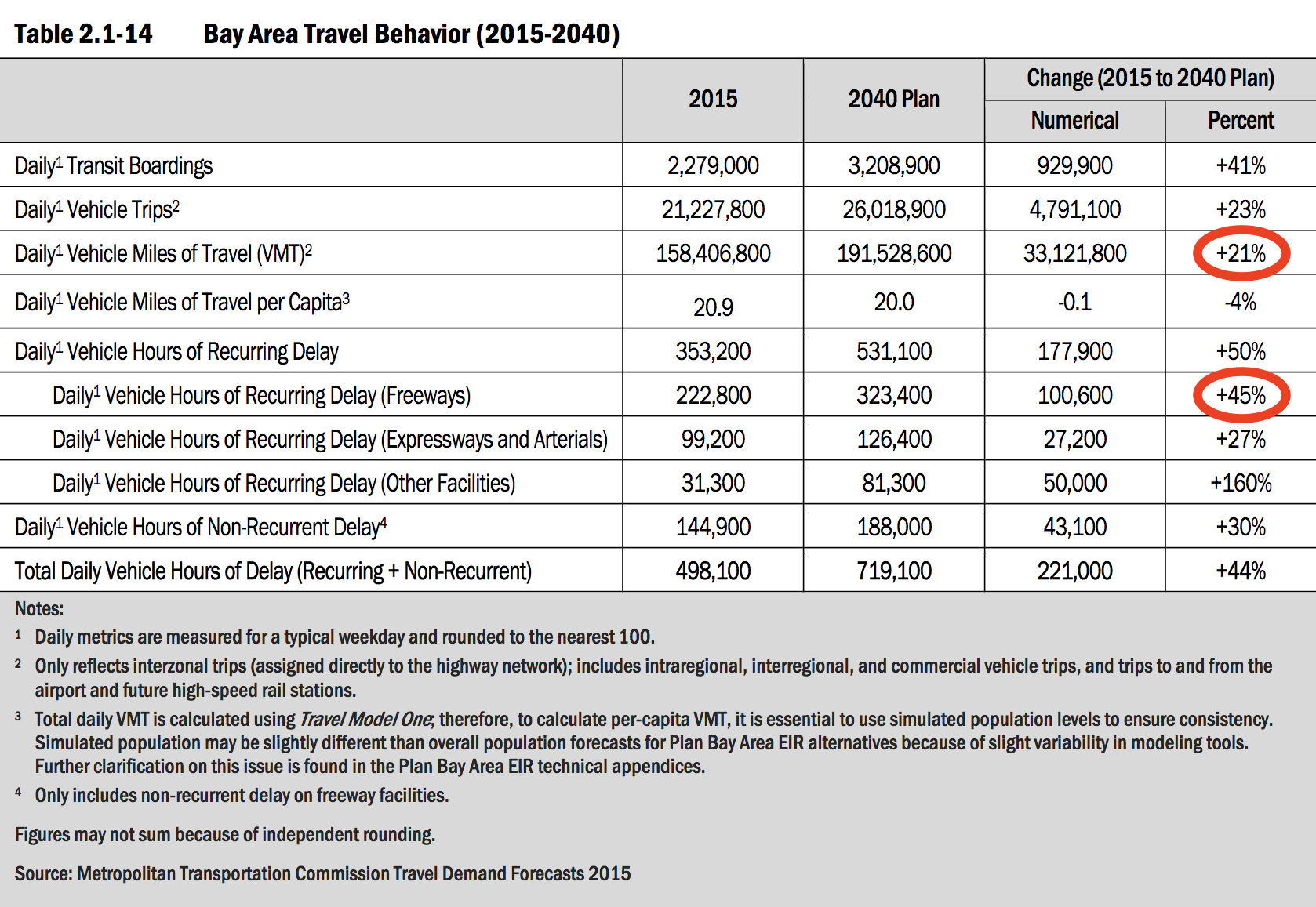By Matt Williams
Our regional transportation plan (Plan Bay Area 2040) will guide the expenditure of $303 billion between now and 2040 to enact transportation and land-use strategies in the nine-county Bay Area. This plan (and this budget) offers an enormous opportunity to influence where people live and how they get around in order to reduce our collective impact on the environment and create “a more sustainable, equitable and economically vibrant future.”
The Sierra Club wholeheartedly supports these goals, as well as the core strategy identified to achieve them: targeted infill development near transit, identified as Priority Development Areas. But we wanted to know: is the plan set up to achieve its goals?
To answer this question I’ve been digging into Plan Bay Area’s 762-page Environmental Impact Report (EIR). I’ve found huge gaps between the plan’s stated goals and what the environmental review indicates it will accomplish. Here’s an overview of my findings so far:
Too Many Cars:
In a prior analysis of the EIR, I showed that Plan Bay Area projects an additional 1.1 million additional vehicles on Bay Area roads by 2040 — not a good start for a plan with the stated goal of “[reducing] per-capita CO2 emissions from cars and light-duty trucks by 15%.” This number of additional vehicles is also in conflict with the vision of compact communities; on already congested local streets, where will 1.1 million more cars be parked? Building parking in new residential developments can’t be the answer, as it takes up limited space and increases costs.

Too Many Miles Driven:
My latest findings underscore the concern that Plan Bay Area will not achieve the required reduction in driving-related emissions. According to Table 2.1-14 (EIR page 151), per capita mileage is only expected to decrease by 4% (the statewide goal is a reduction of 15% by 2020). Aggregate daily vehicle miles traveled, meanwhile, is expected to increase by 21%! Moreover, all of that driving will result in routine traffic delays on freeways increasing by 45%.

Cars Still Dominate the Commute:
One of the objectives of Plan Bay Area’s greenhouse gas reduction strategy is to shift people from cars and light trucks to walking, biking, and mass transit, such as buses. Yet what we find in Table 2.1-15 (EIR page 152) throws cold water on that objective.
By 2040, driving alone will still make up 46.6% of all trips — just 1% less than in 2015. Half of that 1% change will go to carpools and the other half to transit. The share of trips by walking will stay the same and the share of trips by bike are projected to go down.

Overview:
It seems clear from Plan Bay Area’s own environmental review that it will fail to meet the state-mandated requirement to cut greenhouse gas emissions from transportation “through the promotion of more compact, mixed-use residential and commercial neighborhoods near transit”. Adding 1.1 million cars to the road, driving an additional 33 million miles each day, and shifting just 1% of drivers into other modes of transit doesn’t sound like a recipe for success. This raises a fundamental question: If we don’t plan to succeed, how will we?
What We’re Doing:
The Sierra Club is trying to help jumpstart stalled Priority Development Areas to reduce driving-related emissions that contribute to climate change. We’ve hired a full-time organizer who is working to educate elected officials and other decision makers about why Priority Development Areas are key to solving the housing crisis and creating environmentally friendly communities. She is also offering advice, strategies, and resources to help local officials speed up development of affordable housing development in their cities’ PDAs.
Recently we’ve urged our members to speak up in support of affordable infill housing next to transit hubs in downtown Berkeley, Walnut Creek, and Oakland’s Lake Merritt neighborhood, among others. We also advocate for policies such as Accessory Dwelling Units to promote compact growth.
Our efforts to provide housing for all Bay Area residents extend to our political work. In the November 2016 election the local chapter endorsed and worked to pass a dozen affordable-housing ballot measures, including Oakland's Measure KK, San Francisco's Measure C, and Berkeley's Measure U1, which will invest $600 million, $260 million, and an annual $1.5-$4.5 million, respectively, into affordable housing.
What You Can Do:
In order to get local officials fully on board and engaged, we need you, their constituents, to let them know you support the goal of affordable infill housing near transit. Please write or call your elected representatives today and ask them to do everything in their power to make Priority Development Areas in their districts a success. Tell them that the housing crisis and the climate crisis depend on their action in our city centers.
Matt Williams is chair of the Sierra Club SF Bay Chapter's Transportation & Compact Growth Committee.